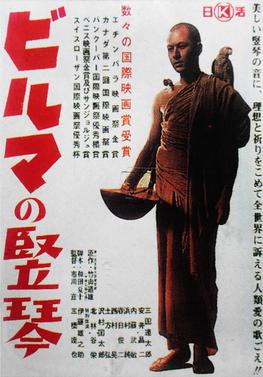“The
Burmese Harp” is a film by Kon Ichikawa (“Fires on the Plain”). He also co-wrote it based on a children’s
book by Michio Takeyama. The book was
more of a fantasy than the movie. It was
nominated for Best Foreign Language Film.
The movie was one of the first Japanese films with a pacifist bent. It was remade by Ichikawa in 1985 and was a
big hit. I have not seen the remake.
The
movie opens in July, 1945 in Burma. A
Japanese company led by Capt. Inouye (Rentaro Mikuni) is retreating across mountains
to try to reach Thailand. One of the
soldiers, named Mizushima (Shoji Yasui), plays a harp. The men are anachronistically healthy,
well-dressed, and not exhausted. (And
this is the director of “Fire on the Plain”?)
They stop at a village and the Burmese give them food without any
coercion. How nice of them. Suddenly, a British column appears. The Japanese join them in singing “Home Sweet
Home” to avoid a firefight. The Brits
inform them that the war has been over for three days. Mizushima volunteers to talk a more warlike
unit into surrendering. They are holding
out in a cave. The negotiations do not
go well as this unit is more typical of the Japanese you find in war
movies. The British are not in a patient
mood and Mizushima is lucky to survive in a life changing incident. He decides to become a monk and bury dead
soldier bodies. His mates want him to
return to Japan with them. They
communicate via talking parrot. Make
sure you get the DVD with parrot subtitles.
“The
Burmese Harp” is certainly different.
While not as fantastic as the source novel, it is like a fable in many
ways. If you treat it that way, you will
be able to overlook the unrealistic elements of it. Most of the plot could only have occurred in
a children’s book. I doubt many Japanese
veterans recognized the Burma of this movie.
For a much more realistic view (although it is set in the Philippines),
watch “Fires on the Plain”. Ichikawa
must have made that movie to balance “The Burmese Harp”. Another fanciful theme is there is no
dysfunction in Mizushima’s unit.
Everyone loves him. It must be
his harp playing. Or his singing. The movie has a lot of songs for a war
movie. I counted eight. Hard core war movie lovers might want to
factor that in when they decide whether to watch the movie. If you don’t like a lot of songs, watch the
movie for its creative cinematography.
It is a film school type movie.
You won’t learn about film clichés from it, however. There is no sinister villain and it is not
predictable. The acting is fine and
there is a unique character in the Burmese woman who trades with them and gives
them the talking parrot.
“The
Burmese Harp” is not a must-see. It is a
nice little movie and I enjoyed it. It
depends on what you are in a mood for.
It and its evil cousin “Fires on the Plain” pretty much cover the two
extremes of moods. Fable or
funereal. Take your pick.

No comments:
Post a Comment
Please fell free to comment. I would love to hear what you think and will respond.